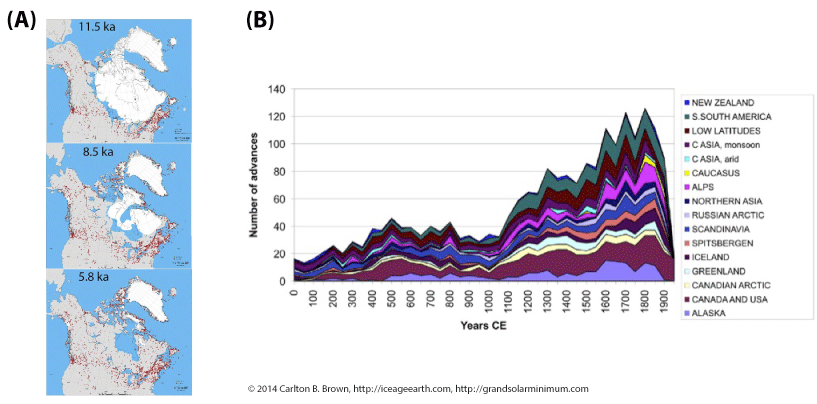Images: A) This image presents three smaller images (from 15) extracted from a time series of the Laurentide and Greenland ice sheets straddling the Holocene Climate Optimum. The complete time series shows a stepwise reduction in ice extent from 11,500 years ago to its minimum extent 5,800 years ago.[i] B) This image shows a stacked time series of glacier advances and retractions during the last two millennia. A small number of glacier advances occurred in many regions between the first and twelfth centuries CE. There was then a sharp increase in the number of glacier advances from the 13th century to the mid-19th century.[ii] During the Little Ice Age winter sea ice closed off previously accessible sea routes between Scandinavia and Greenland.[iii]
Beginning in the mid-19th century, as temperatures increased again, glacier ice began to melt, with this accelerating over the past five decades.[iv],[v],[vi] Based on the second image, we can appreciate that a significant part of the last two millennia of ice accumulation has melted since the mid-19th century.
The key take-home message is that there was less glacier ice in the Arctic at the Holocene Climate Optimum than exists today. Ice then began to accumulate starting about five millennia ago, accelerating through the Little Ice Age in an oscillatory manner until the mid-19th century. The ice melt since the mid-19th century happened during the current global warming phase, or the trough-to-peak warming phase that started in 1700 CE. With most of the last two millennia of ice accumulation having melted recently, it is difficult for us to perceive the correct stage of the glacial cycle that we are living in.
Click on this page and download a free copy of my book “Revolution: Ice Age Re-Entry,” and read more about this topic in Chapter 3.
[i] Jason P. Briner et al., “Holocene climate change in Arctic Canada and Greenland.” Quaternary Science Reviews, Volume 147, 2016, 340-364, ISSN 0277-3791. https://doi.org/10.1016/j.quascirev.2016.02.010.
[ii] O.N. Solomina et al., 2016, “Glacier fluctuations during the past 2000 years.” Quaternary Science Reviews, 149, 61-90. DOI: 10.1016/j.quascirev.2016.04.008. [See Figure 5, page 276. This figure collates a stacked time series of the number of glacier advances and recessions in each region into a global total.].
[iii] Michael E Mann, “Little Ice Age.” Volume 1, The Earth system: physical and chemical dimensions of global environmental change, 504–509. In Encyclopedia of Global Environmental Change (ISBN 0-471-97796-9).
[iv] Leonid Polyak et al., “History of sea ice in the Arctic.” Quaternary Science Reviews 29 (2010) 1757–1778, https://doi.org/10.1016/j.quascirev.2010.02.010
[v] Christophe Kinnard et al., “A changing Arctic seasonal ice zone: Observations from 1870–2003 and possible oceanographic consequences.” Geophysical Research Letters, Volume 35, L02507, doi:10.1029/2007GL032507, 2008.
[vi] O.N. Solomina et al., 2016, “Glacier fluctuations during the past 2000 years.” Quaternary Science Reviews, 149, 61-90. DOI: 10.1016/j.quascirev.2016.04.008. [See Figure 5, page 276. This figure collates a stacked time series of the number of glacier advances and recessions in each region into a global total.].

